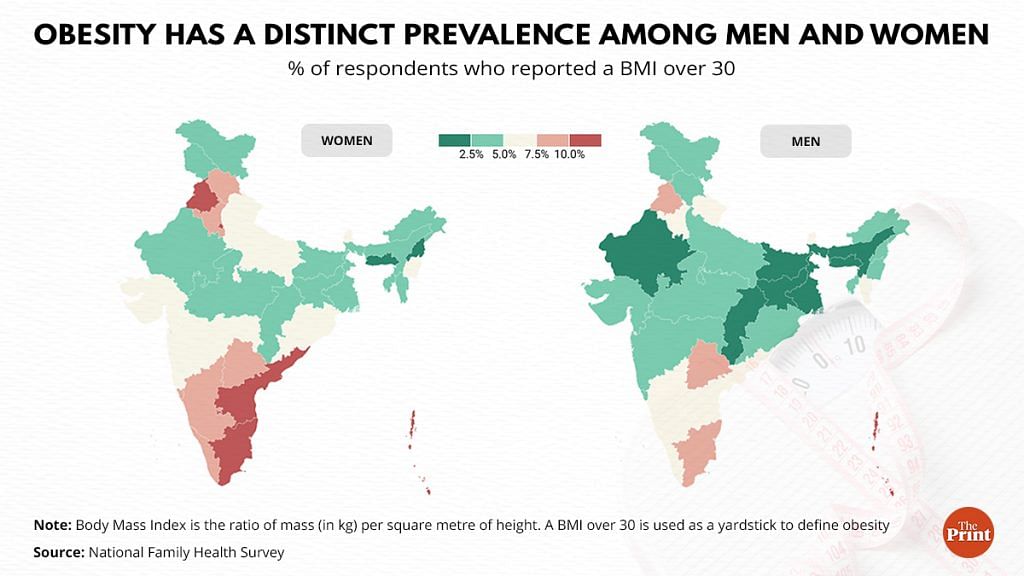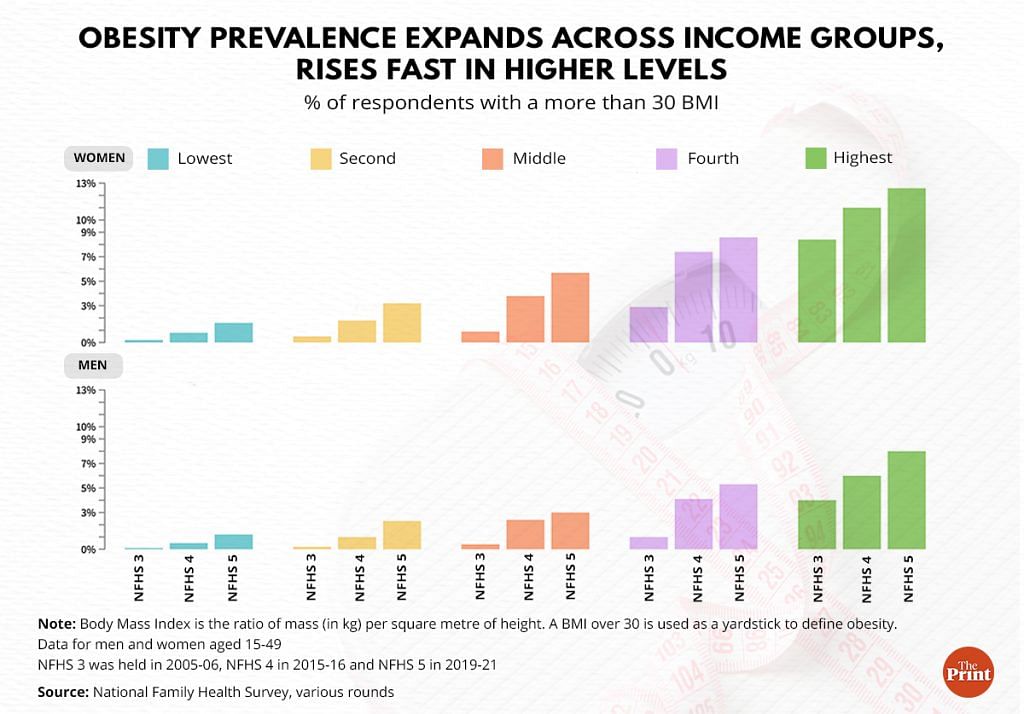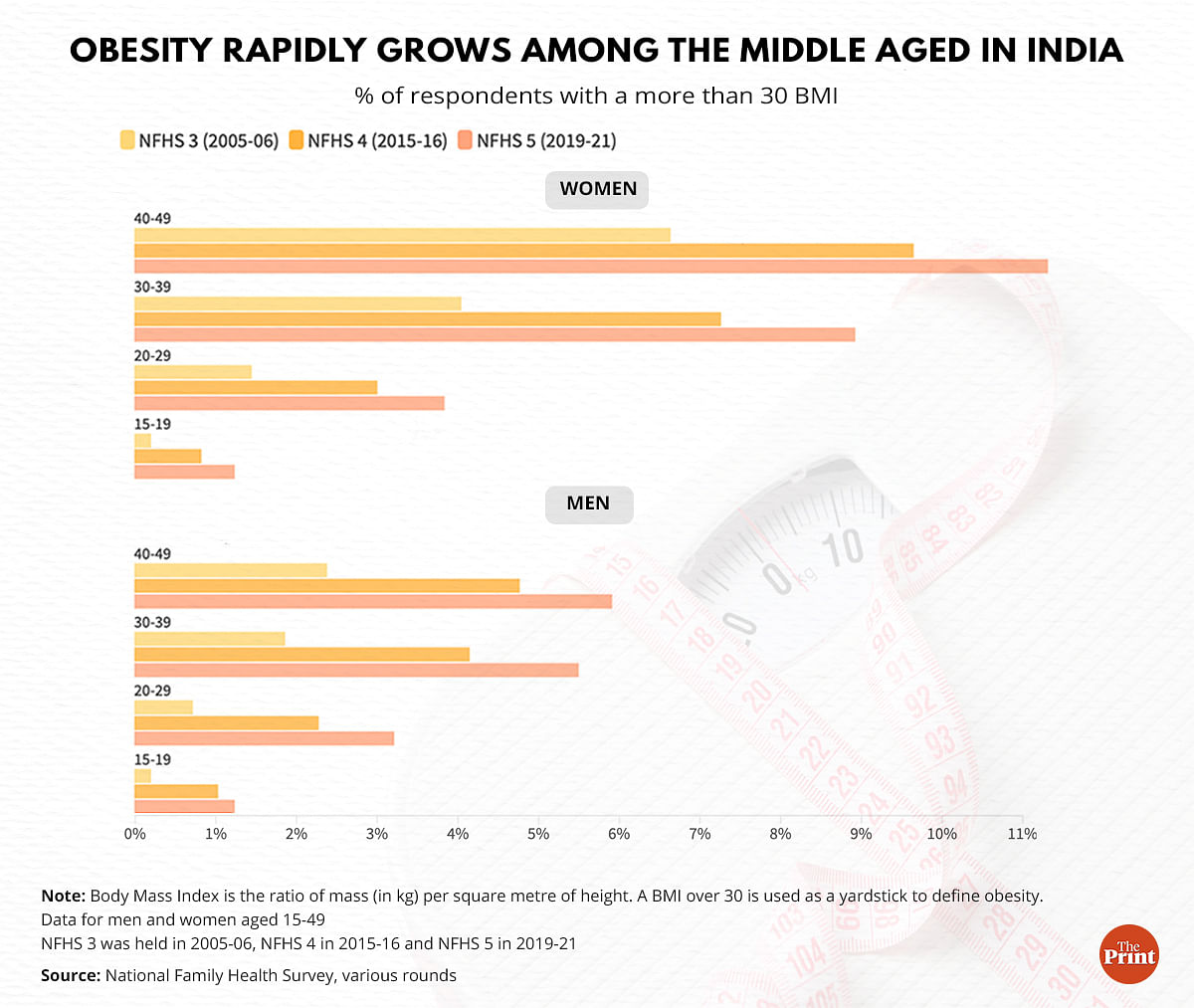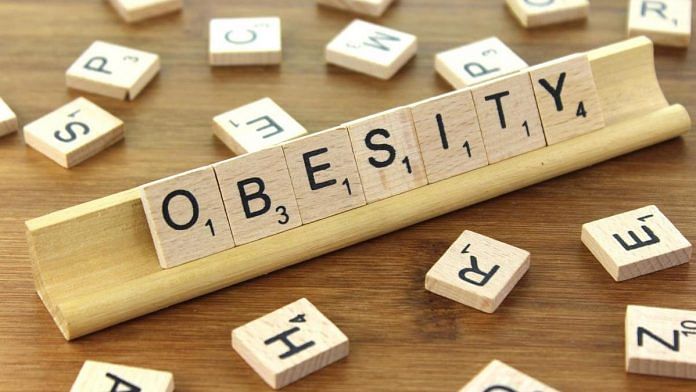New Delhi: Nearly one in 16 women and one in 25 men is obese in India. And Indians have only been growing fatter over the past 15 years, shows data published in the fifth and latest round of the National Family Health Survey (NFHS).
A detailed analysis of NFHS numbers conducted by ThePrint shows that obesity is more prevalent among women than men, seems to afflict the relatively prosperous most (again, especially women), and the so-called “middle-aged spread” is a reality for the Indian waistline.
NFHS is a large-scale, multi-round survey conducted in a representative sample of households throughout India. Five rounds of the survey have been conducted so far, with the first one in 1992-93. The report of the fifth round, conducted in 2019-21, was published last year.
Here’s a look at some of the study’s findings about obesity in India and why some groups tend to be affected more than others.
Also Read: Spot reduction can lure you into thinking you’ll lose stubborn fat. What you must do instead
Obesity gender gap
According to the fifth round of the NFHS conducted between 2019 and 2021, about 6.4 per cent of women and 4.0 per cent of men aged 15-49 are obese.
Around 17.6 per cent women and 18.9 per cent men in the same age group are overweight, but not obese.
This means that about a fourth of young women in India are overweight and a little over a fifth of men are above the normal body weight.

A person is considered obese if their Body Mass Index (BMI) is above 30. The BMI is a ratio of a person’s weight to their height measured in kilograms per meter square of height. A BMI above 25 and below 30 is considered to be overweight but not obese.
There are regional differences, too. In some places, women are a lot more likely to be obese than men. Take for example Delhi, where the survey showed 14.2 per cent of women were obese, but this applied to only 7 per cent of men.
Similarly in Goa, around 9.5 per cent of women (or one in 10) were reportedly obese against only 2.8 per cent of men. Simply put, among every 100 women in the state, at least nine could be expected to be obese. In contrast, just about three out of 100 men might be obese in Goa.
In Punjab, the state with the highest obesity rate in India, about 14.2 per cent women and 8.3 per cent men were found to be obese. In Andhra Pradesh, 12 per cent women and 6 per cent men reported a BMI over 30. In Tamil Nadu, 14.1 per cent women and 8.7 per cent men were obese.
There were only three states, all in the northeast, where more men were reported to be obese than women, but the gender difference was small.
Around 5.6 per cent men and 4.6 per cent women were found to be obese in Mizoram. About 2.6 per cent men and 1.8 per cent women were found obese in Nagaland. For Meghalaya, the percentage of obese men and women was 1.6 per cent and 1.4 per cent respectively.
Dr Hemalatha R, director of the National Institute of Nutrition, an Indian Council of Medical Research (ICMR) body, explained the possible reasons for the gender gap in obesity rates.
“Studies have shown that women tend to have a lower basal metabolic rate compared to men. Also, the amount of energy that they spend on the same physical activity is likely to be lower than that of men. Differences in the body composition, hormones also may explain such differences,” she said.
More money, more kilos?
The NFHS data suggests that obesity and wealth are bedfellows. And that the richest women are most affected.

The wealth groups were divided into five quintiles, of which the lowest corresponds to the population at the bottom 20 per cent of the wealth pyramid, and the highest to the top 20 per cent of the wealth distribution.
According to the survey, in 2019-21, 12.6 per cent of women (or one in eight) were found to be obese in the top wealth group on average in India. The obesity rate in the bottom 20 per cent wealth group was just 1.6 per cent or less than two for every 100 women aged 15-49.
Among men, the obesity rate for the top wealth quintile was 8 per cent and 1.2 per cent for those in the bottom wealth quintile.
Past years’ trends show that obesity has risen across all income groups, but the sharpest increase has been observed in people who belong to either the middle or higher wealth quintiles.
For instance, in 2005-06, for every 100 women in the middle-income group, there wasn’t even one woman who was found to be obese (0.9 per cent). Fast forward to 2019-21, nearly every one in 17 women in the middle wealth quintile is obese (5.7 per cent). The obesity rate among wealthier women in the top quintile has jumped from 8.4 per cent (one in 12) to 12.6 per cent (one in eight).
The rate of obesity among men is relatively low, but the trend is similar. Only 0.4 per cent of men in the middle wealth quintile were reported to be obese in 2005-06, but this rose to 3 per cent in 2019-21.
In the top wealth quintile, 4 per cent of men were reported to be obese in 2005-06, which went up 8 per cent in 2019-21.
Dr Hemlatha R explained why obesity tends to prevail more among the prosperous.
“Although wealthier individuals have higher purchasing power, we cannot be sure that they will spend on healthier food options. With increased access to processed foods and sugary edibles, which contain way too many calories and sugars and very poor nutrition, they may end up having more of such foods. This may partially explain higher obesity among upper wealth quintiles apart from low physical activity due to change in lifestyles,” she said.
Older and wider
Age appears to play a significant role in obesity, with the battle of the bulge being the greatest for those in the 40-49 age group.

According to the survey, in 2019-21, about 11 per cent women in the 40-49 age group were found to be obese, and the same for men was about 5.7 per cent, both of which were above the average national obesity rates.
When asked about this, Dr. Hemlatha R said: “Middle-aged individuals are more likely to be economically independent with increased purchasing power and are likely to be less active, hence higher chances of becoming obese or overweight.”
She added that as people grow older, their calorie/energy requirements decrease. “Hence, one should consume fewer calories and continue physical activity as age advances,” she said.
Food for thought
The NFHS also includes data on eating habits. ThePrint pegged the state-wise obesity prevalence to the percentage of men and women who reported consuming fried foods and aerated drinks at least once a week. However, no clear relationship emerged between the prevalence of obesity and unhealthy eating habits.
For instance in Punjab, where the obesity prevalence was the highest, 25 per cent of women and 28.8 per cent of men reported eating fried food at least once a week. But in Mizoram, where the obesity rate is low, people seemed to have a huge penchant for fried treats. As many as 93 per cent women and men each reported consuming fried food at least once a week.
This data appears to belie the accepted wisdom that consuming high-calorie fried food leads to obesity. But this is not necessarily a green signal to stock up on samosas.
Dr. Hemalatha R explained that the relationship between consumption habits and obesity is not that simple.
“A person who does not engage in physical activities and consumes more calories than required is more likely to get obese. But people who frequently consume junk foods and still report a normal BMI are not healthy either,” she said.
Fatty, sugary, and processed foods, she added, have a negative impact on health, whether or not this manifests in the form of a widened girth.
“Even if someone isn’t obese, she/he may have altered body composition with more fat around the trunk (central obesity) and have less overall muscle mass. These individuals appear normal or even underweight, but may be fatty from inside due to poor dietary habits and lack of physical activity. These individuals are at higher risk of type-2 diabetes, cardiovascular diseases, fatty liver, and are prone to heart attacks, something which people suffering from obesity also face,” she said.
(Edited by Geethalakshmi Ramanathan)
Also Read: What causes childhood obesity? New study says a single gene could be responsible



